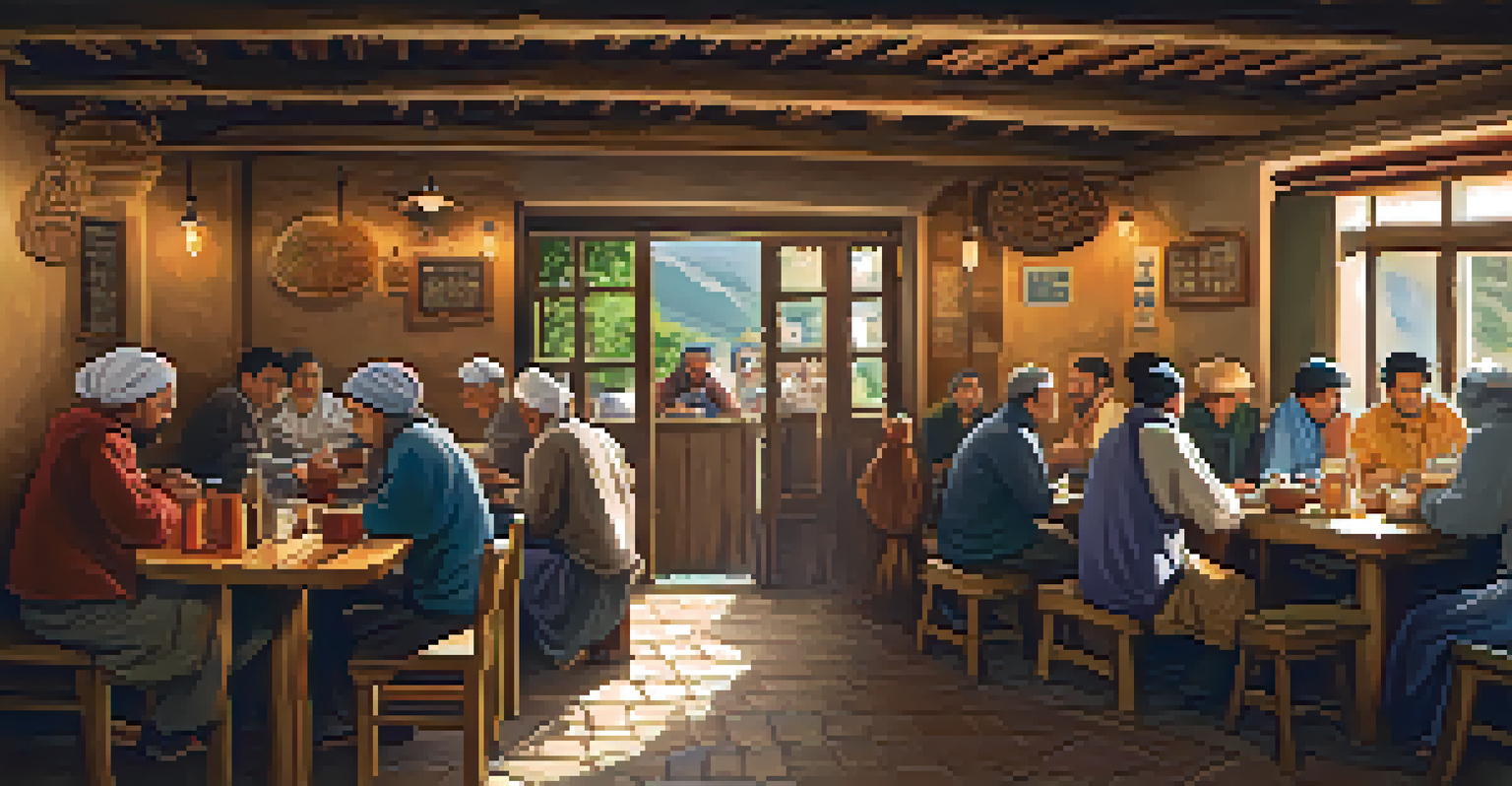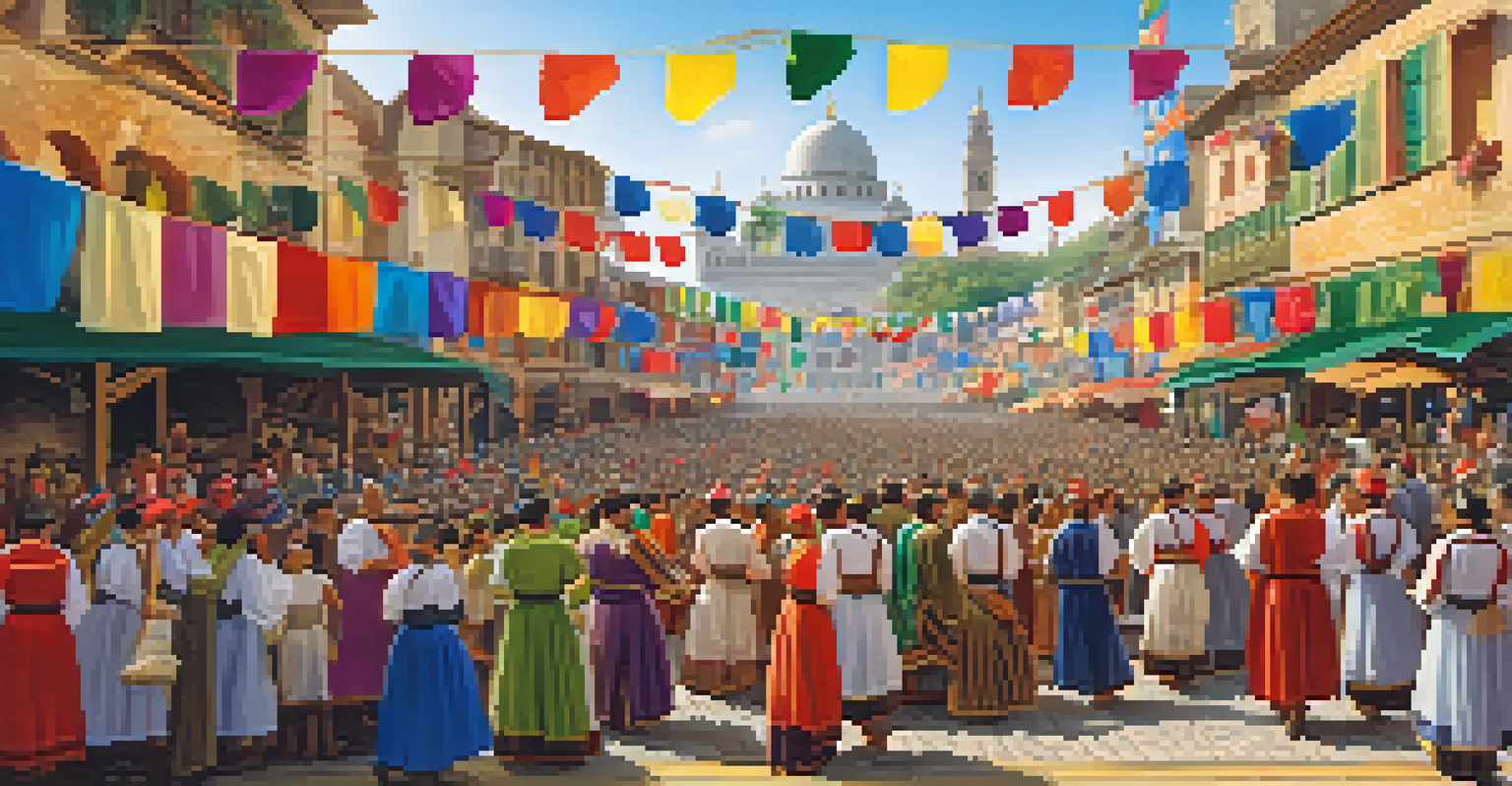How Pilgrimages Foster Community and Cultural Exchange

Understanding the Essence of Pilgrimages
Pilgrimages are journeys undertaken for spiritual or religious reasons, often leading individuals to sacred sites. They have been a part of diverse cultures for centuries, serving as a means of connection to the divine. Beyond their spiritual significance, these journeys also create opportunities for community building among participants.
The journey itself is my home.
For instance, the Camino de Santiago draws thousands each year, showcasing not only personal devotion but also collective experiences among pilgrims. Each traveler brings their story, contributing to a rich tapestry of shared narratives and traditions. This blend of personal and communal elements highlights the multifaceted nature of pilgrimages.
In essence, pilgrimages are about more than just reaching a destination; they foster a sense of belonging and shared purpose, connecting individuals to each other and the larger cultural landscape.
Cultural Exchange Through Shared Experiences
As pilgrims embark on their journeys, they often encounter diverse cultures, languages, and customs. This exposure fosters an environment ripe for cultural exchange and understanding. For example, the interactions between pilgrims from different backgrounds can lead to the sharing of traditions, foods, and stories.

These exchanges enrich the pilgrimage experience, allowing participants to learn from one another and appreciate different perspectives. A simple conversation over a shared meal can turn into a profound exchange of ideas and values. Such moments not only enhance individual journeys but also cultivate a sense of unity among diverse groups.
Pilgrimages Foster Community Bonds
Shared journeys during pilgrimages create deep connections among participants, turning strangers into lifelong friends.
Ultimately, the cultural exchange that occurs during pilgrimages helps to break down barriers, fostering mutual respect and understanding among participants.
Building Community Through Shared Goals
Pilgrimages often involve a shared goal or purpose, which naturally brings people together. As participants walk, cycle, or travel toward a common destination, they forge bonds through their collective experiences. This shared journey cultivates camaraderie and a sense of accountability among pilgrims.
Traveling – it leaves you speechless, then turns you into a storyteller.
For instance, many pilgrims offer support to one another, whether it's sharing supplies or encouraging words during challenging moments. These acts of kindness not only enhance the journey but also create lasting friendships that can extend well beyond the pilgrimage. The power of shared goals can transform strangers into lifelong companions.
In this way, the pilgrimage experience becomes a microcosm of community life, highlighting the importance of collaboration and support in achieving common aspirations.
The Role of Local Communities in Pilgrimages
Local communities play a crucial role in the pilgrimage experience, welcoming travelers and sharing their culture. Many towns along popular pilgrimage routes have developed services, such as hostels and eateries, specifically catering to pilgrims. This not only provides essential support but also fosters a spirit of hospitality.
Through their interactions with local residents, pilgrims gain insight into the area's history, traditions, and way of life. These exchanges can lead to a deeper appreciation of the culture that surrounds them and reinforce the importance of community connections. Local festivals and events often coincide with pilgrimage seasons, further enriching the experience.
Cultural Exchange Enhances Experience
Interactions between diverse pilgrims enrich the journey through the sharing of traditions, stories, and perspectives.
The relationship between pilgrims and local communities highlights how these journeys can promote cultural exchange, benefiting both visitors and residents alike.
Preserving Cultural Heritage Through Pilgrimages
Pilgrimages often serve as a means of preserving cultural heritage, as they encourage the continuation of traditional practices and rituals. Many pilgrimage routes are steeped in history, with landmarks and customs that have been passed down through generations. By participating in these journeys, pilgrims become part of a living tradition that honors the past.
For example, festivals and ceremonies linked to specific pilgrimage routes often include age-old practices that reinforce community identity. These events not only attract pilgrims but also engage local residents, ensuring that cultural heritage remains vibrant and relevant. As a result, each pilgrimage contributes to the ongoing narrative of a community's history.
Thus, the act of pilgrimage can be seen as both a personal journey and a collective effort to preserve cultural identity for future generations.
Fostering Empathy and Understanding Among Cultures
One of the most profound impacts of pilgrimages is their ability to foster empathy and understanding between different cultures. As pilgrims interact with one another, they encounter diverse worldviews that challenge preconceived notions. This exposure helps to cultivate a sense of empathy, which is crucial in our increasingly interconnected world.
For instance, when pilgrims share their stories and experiences, they often find common ground despite cultural differences. These conversations can lead to a greater appreciation of each other’s struggles and triumphs, deepening bonds among participants. The result is a powerful reminder of our shared humanity.
Preserving Heritage Through Tradition
Pilgrimages help maintain cultural heritage by encouraging the continuation of rituals and practices that define community identity.
In this way, pilgrimages serve as a bridge between cultures, promoting peace and understanding through shared experiences.
The Lasting Impact of Pilgrimages on Communities
The impact of pilgrimages extends far beyond the journey itself, leaving lasting impressions on both participants and communities. Pilgrims often return home with new perspectives, enriched by the experiences and connections made along the way. This newfound awareness can inspire them to engage more deeply with their own communities.
Additionally, communities that host pilgrims often experience renewed interest in their cultural heritage and traditions. This revitalization can lead to increased tourism, economic opportunities, and a greater sense of pride among residents. The cycle of giving and receiving during pilgrimages creates a dynamic exchange that benefits everyone involved.

Ultimately, the lasting impact of pilgrimages fosters a ripple effect, encouraging a spirit of community and cultural appreciation that can resonate for years.